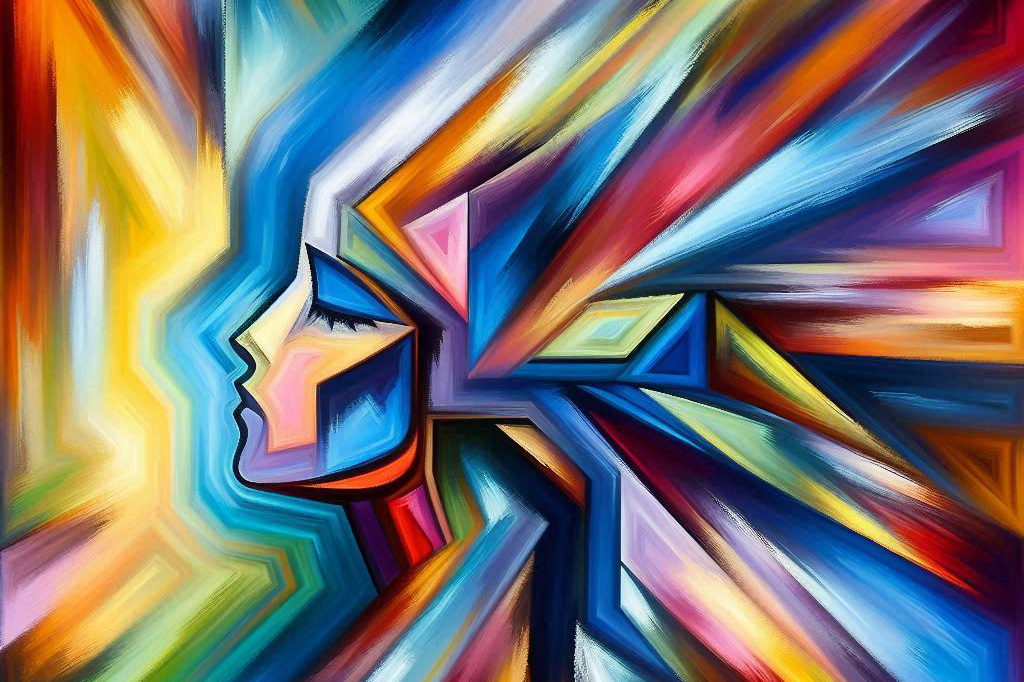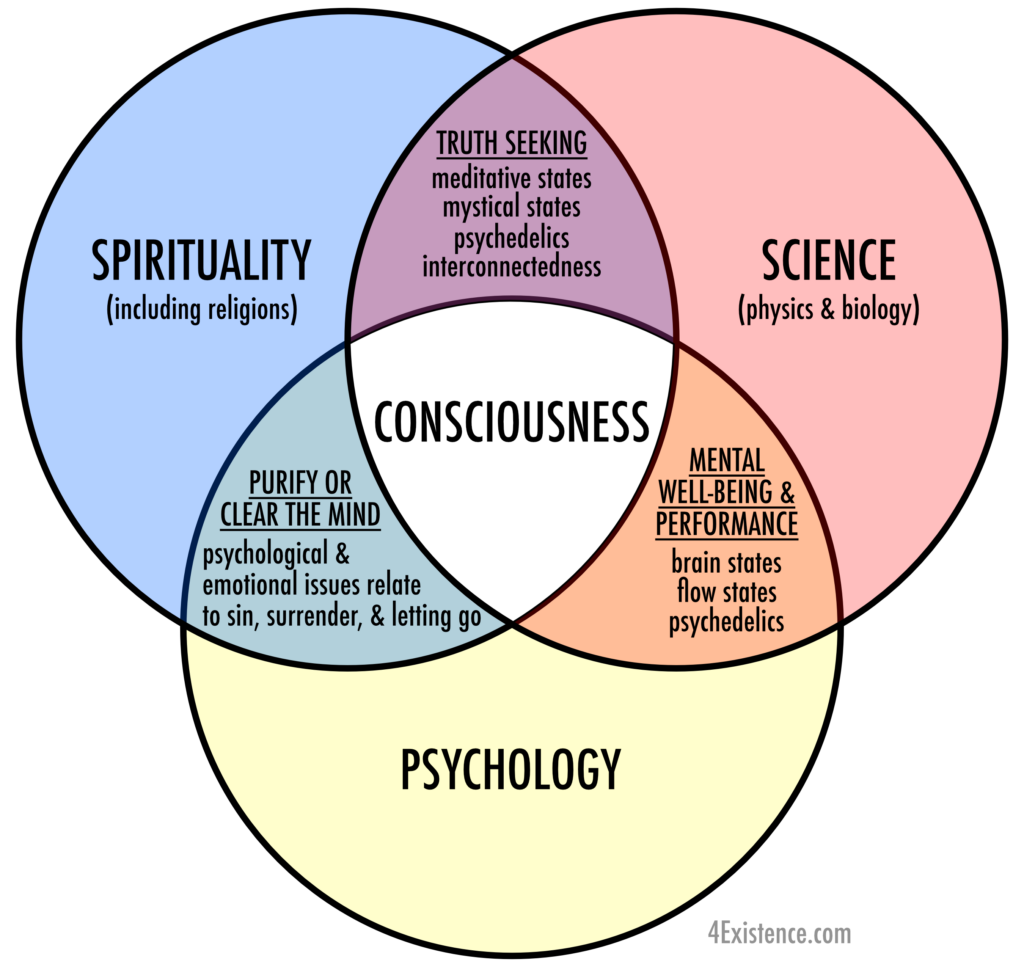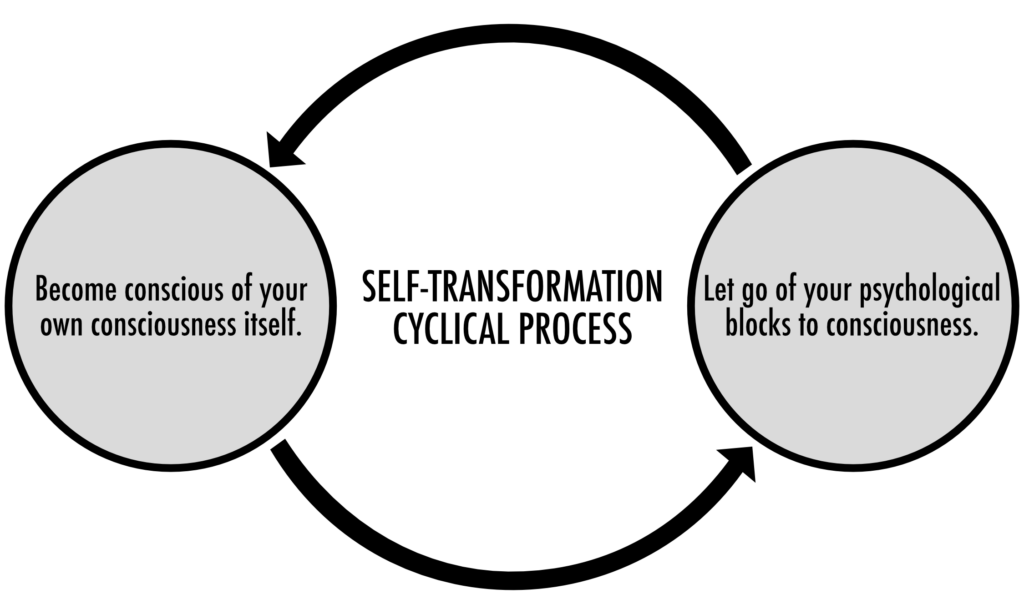
There are infinite routes to self-transformation. A wide range of approaches through religion, spirituality, psychology, self-help, personal development, and science offer us opportunity to move ourselves toward stress reduction, happiness, inner peace, self-improvement, personal growth, enhanced performance, and general well-being.
However, it can be easy to spin your wheels, plateau in an unfulfilling way, or even take steps backwards right when you think you’re making progress.
What is it specifically that moves people forward at all with their self-transformation? Is there something common to all effective approaches to self-transformation that can become a focus to make whatever path you choose much more effective?
Fortunately, yes, there is! However, it is often inapparent, not communicated directly, and in many cases not even known to those offering education around their respective subject areas.
That common denominator is consciousness itself.
What is Consciousness?
To see why consciousness itself is an integral common denominator for self-transformation, first we need to have at least a little understanding of what consciousness is.
The word “consciousness” has different meaning in different contexts. It can be associated with mystical and ethereal themes, yet is actually quite tangible.
As you know, you are conscious right now. For all of the known experience you have had in your entire life, no matter if the experience is deemed good or bad, you have obviously been conscious. However, do you have a sense of your consciousness itself? Can you sense or notice your own consciousness itself right now? Let’s explore this a little more.
All of the sensory input that comes through your senses, as well as all of your thoughts and emotions, eventually reach your consciousness. It can help to think of it like a mirror for everything you can sense, and that includes thoughts and emotions. The mirror reflects all of the input while it remains perfectly still and non-judgmental.
In order to truly understand what I’m talking about about, the mind can only take you so far. You have to explore it experientially. To do this, let’s try a short exercise.
Try closing your eyes and imagining losing all of your senses, and being left with just your thoughts and emotions. You can’t see, hear, smell, taste, or touch, but you can still think and feel emotions.
Then, imagine what within you is aware of the thoughts and emotions. What senses them if you have no more senses? The thoughts and emotions can’t sense themselves as that is not their function. There is something more that senses them. That something sensing them is consciousness.
Once you settle into this experience, go ahead and take it one more step and imagine removing the thoughts and emotions. What’s left?
What is left is consciousness on its own, aware of nothing else but itself. This is consciousness itself.
Consciousness is what is aware of everything in all of your experience.
Consciousness is what is aware of everything in all of your experience. It is unmoved by the coming and going of all phenomena in your life, including sights, sounds, scents, flavors, anything that touches you, thoughts, and emotions. It observes all of this without judgement no matter your mind’s interpretation of it.
How does consciousness itself transform you?
So, you know that you’re conscious and now you might have a little sense of what consciousness itself is experientially. You might think “big deal”. Totally understandable, but there’s a lot more to the story.
Becoming aware of consciousness itself is extremely transformative. It brings your mind into the present moment and provides reason that gives it permission to let go.
It brings your mind into the present moment and provides reason that gives it permission to let go.
That reason for letting go is because the mind can see that the consciousness is primary to itself. In other words, all the thoughts that come through the mind come and go to the phenomenon of consciousness that is already and always there.
The mind may be shocked by this at first notice, but over time, as it revisits consciousness itself, it will begin to trust it. As the mind trusts it, it will start to see it as a more accurate definition of what you are than how you currently define yourself.
For example, you may currently define yourself by your life roles, beliefs, actions, personality, and what has happened to you, and that can be useful for some purposes. However, these elements of identity all come and go when viewed from the perspective of consciousness itself. Consciousness remains steadfast through all of it, no matter how good or bad.
It can take some time for the mind to consistently see consciousness from this perspective, but once it does, it can trust it as more reliable and true than itself. Once this trust sets in, the mind can realize it is safe to let go and allow consciousness to take the forefront of experience.
When the mind lets go, allowing yourself to be purely conscious without the impact of thoughts and emotions (whether or not they arise), you are free. This freedom is often described in spirituality with words such as enlightenment, samhadi, heaven on earth, union with the divine.
This might sound overly simplistic, and it is truly simple. However, that doesn’t mean it is easy.
The mind is a force that is humanity’s biggest challenge. Our minds do more than we can imagine to cause our suffering, and it is a highly complex and habitual “animal”.
Because it is oriented toward survival, it is naturally consumed by fear and desire, which can lead to emotional repression and all the surface emotions that pain us, like sadness, anger, guilt, shame, frustration, etc.
The vast majority of suffering comes from the mind, yet it is only because it has not seen consciousness itself as the reality of what you are. It is like a short circuit of the mind to see this reality, which is why consciousness must be seen experientially.
Efficient self-transformation happens when the mind realizes that consciousness is primary to itself and can lead the way of your actions. This does not mean that thinking can’t be done or that thinking isn’t useful. It just means there is another level where thought is derived that the mind cannot control.
When the mind lets go, transformation begins.
When this is seen experientially, the mind can let go. When the mind lets go, transformation begins. Fears and stresses that don’t serve you begin to fall away. Wants and desires that don’t serve you fall away. You can live life freely, more honestly and energetically, and with a sense of clarity and completeness at all times, with every action you choose to take.
How is consciousness an integral common denominator?
Consciousness itself is such a powerful and core aspect of our reality and well-being that it can be easily seen as a common denominator to effective approaches to human well-being in spirituality, psychology, and science.
Once you have an experiential understanding of consciousness itself, you can start to connect the dots of how its realization is the critical driver for what moves you forward with whatever self-transformation approach you use.
While the following Venn diagram is not exhaustive of the overlap of consciousness with spirituality, psychology, and science, it offers some helpful examples, and we’ll get into more detail about it in a moment.

Let’s look at each of these three categories of self-transformation and their relationship to consciousness itself in more detail.
In order to do so, it is helpful to know that the two key ways that consciousness connects to effective approaches to human well-being is by making us aware of our own consciousness itself and by helping us to let go of our psychological or emotional blocks to consciousness. The cyclical process looks like this:

When you are conscious of your own consciousness itself, you are brought into the present moment and see reality for what it is rather than your mind’s interpretation of it. When you let go of your psychological blocks to consciousness, you are removing the thoughts and emotions that don’t serve you. You can still think and process emotions, but in more useful and functional ways. This removal of the clutter clears the way for you to be purely conscious.
Now we can more deeply explore how consciousness fits into effective approaches to human well-being from spirituality, psychology, and science in the context of this 2-step cyclical process.
SPIRITUALITY
Become Conscious of Consciousness Itself
Spiritual or religious practices like ritual, song, prayer, chanting, or meditation bring the practicing individual firmly into the present moment during the activity. They are mechanisms that enable a letting go or surrendering of the mind so that pure consciousness is at the forefront of the person’s experience.
In spiritual or religious terms, they allow one to embody pure consciousness, enlightenment, love, soul, spirit, or to connect or have union with the divine or God. For the purpose of this discussion, these practices enable one to become conscious of consciousness itself.
Here are examples of how Western and Eastern religions and philosophies refer to consciousness itself and the “state” of pure consciousness:
- Christianity & Catholicism – Christ Consciousness, Divine Presence, Soul, Holy Spirit, Beatific Vision, Union with God, Unitive Consciousness; Consciousness is referenced in other ways and with other wording in the Sermon on the Mount and other teachings of the Bible and Jesus Christ, as well as through teachings of St. Francis of Assisi, St. John of the Cross, St. Thomas Aquinas, Meister Eckhart, and modern teachers like Carmelite Nun Bernadette Roberts, Jesuit Priest Anthony DiMello, Trappist Monk James Finley, and Franciscan Friar Richard Rhor.
- Judaism – Neshamah, which is one of the highest levels of the soul, reflecting pure consciousness and connection to God.
- Islam – Ruh refers to spirit or soul, and it is considered the divine breath of life given by Allah; Sufi teachings often explore union with the divine, and emphasize the experiential realization of the Divine presence within oneself and in all of creation.
- Buddhism – Awakening (Bodhi), Enlightenment (Nirvana), Samadhi, Shunya all refer to aspects of the realization of pure consciousness.
- Hinduism – Awakening, Enlightenment (Moksha), Turiya, Samadhi, Shunya, Advaita Vedanta, Upanishads all refer to aspects of the realization of pure consciousness.
Let Go Of Psychological Blocks To Consciousness
Many religions and spiritual traditions also want to bring purification to the mind and seek the eradication of sin. Homolies, scripture, sacred writings, and spiritual teachings help practitioners sort through their morality and life’s issues that impact their psychology and emotions.
Actions like prayer, confession, and repentance help relieve guilt, shame, and fear, which otherwise occupy the mind to keep consciousness from being in the forefront of experience. These spiritual activities enable the letting go of psychological blocks to consciousness.
The major Western and Eastern religions and philosophies each have their sacred texts that include teachings around morality, ethics, and living a righteous and wise life. While there are other examples, here are a few:
- Christianity & Catholicism – The Sermon on the Mount and other teachings of the New Testament; Catholicism also utilizes the Catechism.
- Judaism – The Torah
- Islam – The Quran
- Buddhism – The Dhammapada, The Eightfold Path
- Hinduism – Bhagavad Gita
Aligning one’s mind, actions, and life with the teachings of these texts is intended to purify the mind, which when successful, can have the effect of letting go of psychological blocks to consciousness itself, or as many teachings describe in various wording, to realize union with God.
PSYCHOLOGY
Become Conscious of Consciousness Itself
Some types of psychological therapy like Dialectical Behavioral Therapy, Acceptance and Commitment Therapy, and Mindfulness-Based Cognitive Therapy use mindfulness to bring the patient into the present moment, drawing their mind closer to alignment to consciousness and priming it toward acceptance and letting go.
Let Go Of Psychological Blocks To Consciousness
Psychology has significant focus on bringing consciousness to distressing patterns of thought and behavior, as well as to unconscious and repressed emotions and experiences from one’s past in order for a person to cope and let go of them.
This increases one’s consciousness both through introspective exploration toward the truth of one’s self, but also through the letting go of what occupies and troubles the mind to keep the individual from experiencing pure consciousness.
Examples of common therapeutic methods in this context include Cognitive Behavioral Therapy (CBT) and Psychoanalytical Therapy.
Additionally, the vast worlds of self-help and personal development include many methods derived from psychology’s advances, but they also include hybrids of methods from psychology and teachings from spirituality that incorporate letting go of the past, repressed emotions, and psychological attachments so that the mind can become clearer and quieter.
SCIENCE
Become Conscious of Consciousness Itself
Studies of both meditation and psychedelics around mystical experiences, neurobiological mechanisms (like serotonin, dopamine and oxytocin relating to states of consciousness), the default mode network (DMN) and the impact on other areas of the brain in relation to consciousness inform areas of psychology and show promise for positively impacting emotional well-being.
Studies of brain wave states show strong relationships of gamma and theta wave states with seasoned meditators and those that claim to be enlightened. These brain states produce effects like heightened perception, deep relaxation, and states of profound insight and oneness, which are commonly reported with experiences described for enlightenment.
Studies around flow states (or being “in the zone”) show brain changes that are consistent with bringing the individual closer to states of pure consciousness and contribute positively to human performance.
Studies in quantum physics aim at proving that human consciousness originates from the quantum level, which may offer a range of insight toward human nature and improving mental health. A recent study around the microtubules within neurons took a big step toward this aim.
Other examples of activities that lean toward scientific exploration, but can also qualify under psychology and spirituality, are ice baths and fasting. While ice baths have positive effects on the nervous system and hormonal processes, the shock of the cold draws one away from anxious thoughts and into the present moment with heightened consciousness. Fasting may trigger a survival instinct where the related discomfort and biological reactions naturally draw one into the present moment.
Let Go Of Psychological Blocks To Consciousness
Certain types of psychedelics that are being studied may help by promoting neuroplasticity, fostering a sense of connectedness and meaning, and enhancing emotional processing, thus assisting in the letting go of psychological blocks to consciousness. Psychedelics in this category of scientific study include Ayahuasca, Psilocybin, MDMA, LSD, and Ketamine.
What steps can you take to transform with consciousness?
As described in the above exploration of consciousness in the context of Spirituality, Psychology, and Science, there is a key way that consciousness connects to the most effective approaches to human well-being. It is encompassed by the following cyclical process:

By making this process the focus of the self-transformational path that we choose, our progress will be much more efficient.
These two cyclical steps do not have to be done in a particular order, nor in prescribed amounts or timing. However, these two steps in some combination of timing and application are essentially what is unfolding when approaches to human well-being are effective.
Additionally, one step begets the other. In other words, the more you become conscious of your consciousness itself, the more you become aware in the present moment so that you are more equipped to identify and let go of your psychological blocks to consciousness. The more you let go of your psychological blocks to consciousness, the more your mind becomes clear to allow you to become aware of consciousness itself.
This is not a quick fix, nor is it likely that a quick fix can exist with something so ubiquitous and time tested as human suffering.
One aspect of the process, becoming conscious of consciousness itself, is very simple in nature, but it can be quite aloof for a given state of mind.
On top of that, the second step of letting go of psychological blocks is a huge challenge in itself. It requires a level of courage and fortitude to face oneself honestly and leave no stone unturned, including those that cover seemingly trivial emotional issues as well as those that are traumatic, repressed, and deep seated.
The noticeable progress with this process usually unfolds gradually over time, and likely includes gradual changes in the neural pathways of your brain that make up your habitual thoughts patterns. However, you are likely to find that once you get the hang of applying it to your chosen path of self-transformation, the progress will be much more clear and efficient than without it.
The process requires introspection and for you to be very honest with yourself so that you can see the reality of yourself much more clearly. There can be plenty of ups and downs along the way, but you will always have a true north in consciousness itself, and the more moments of pure consciousness that you experience, the more you will see its power and be confident in your path.
A Convenient Way To Learn
There are many techniques and approaches that can be used to realize consciousness itself and have it transform your life. Some or many of them you may already use, and it’s just a matter of adjusting your perspective and tactics.
The opportunities to customize the process I have described in order for it to be optimized for your life and current self-transformation approaches are endless. For this reason, most of the content 4Existence offers is oriented toward helping you navigate the process.
For a convenient way to learn more about how to realize consciousness itself and incorporate it into your self-transformation process, click the button below to join the Relatable Consciousness Program. It’s free, and it’s via email so you can go at your own pace.